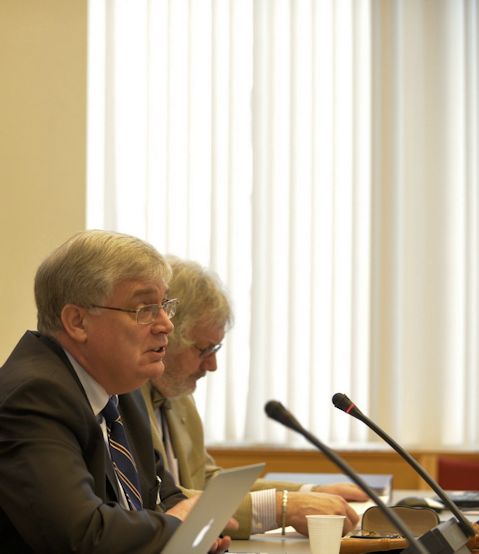Not so dead lines ‒ some updates and corrections
In my posting of 24 November Not so dead lines I tried to assess the composition of Syria’s chemical weapon (CW) arsenal based on official statements, the decision of 15 November by the Executive Council of the Organisaton for the Prohibition of Chemical Weapons (OPCW) and the publication of the Request for Expression of Interest (EOI) inviting commercial companies to participate in the disposal of chemicals and resulting effluent. Given that several elements were based on conjecture, deduction and rough calculations, I offered them with caution pending confirmation. This post supplements, updates and corrects the previous entry. I have retained …
Sea-based destruction of Syria’s CW proposed
A few days ago the press revealed that the United States has offered to neutralise some of Syria’s most dangerous chemicals aboard the Maritime Administration vessel MV Cape Ray. In the margins of the Conference of the States Parties to the Chemical Weapons Convention (CWC) currently underway in The Hague, more details about the proposed neutralisation process have become available. At the time of writing, it appears that the US proposal is the only viable chemical weapon (CW) disposal method on the table. Although a decision on method of destruction for Priority 1 chemicals is not expected before 17 December …
Allegations of CW use in Syria revisited
Since acceding the the Chemical Weapons Convention (CWC) last month, Syria has submitted detailed declarations about its chemical weapon (CW) holdings and activities. While confidential, details of the composition of the CW arsenal have emerged from documents published by the Organisation for the Prohibition of Chemical Weapons (OPCW). In particular, the publication of a request for expression of interest (EOI) by the commercial industry to dispose of certain toxic materials or their effluents has shed some light on Syria’s declarations. Looking at the listing of chemicals in the EOI, two substances intrigue me with regard to allegations of CW use …
Not so dead lines
If ever you had the impression that things had calmed down over the destruction of Syria’s chemical weapons (CW), you may be in for a bad surprise. The already frenzied pace of developments has just picked up again. On 15 November the OPCW decided on the timelines for the destruction and removal of Syria’s chemical weapon (CW) capacity. In parallel developments, countries that had been hoped to host the destruction operations kindly thanked the United States for the honour and politely refused. It basically left the Organisation for the Prohibition of Chemical Weapons (OPCW)—aka the global community—with very few options: …
Syria's declared precursor chemicals
Nitrogen mustard Triethylamine 30 tonnes Monoisopropylamine 40 tonnes Mustard agents (general) 2-chloroethanol 5 tonnes V-agents Di-isopropyl aminoethanol 5 tonnes Sodium-o-ethyl methyl phosphonothionate 130 tonnes N (2-chloroethyl)-N-isopropyl propan 2 amine (salt) 40 tonnes N (2-chloroethyl)-N-isopropyl propan 2 amine (solution 23-64%) 90 tonnes N (2-chloroethyl)-N-ethyl propan 2 amine (solution 23-64%) 25 tonnes Sarin Propan-2-ol (= Isopropyl alcohol or isopropanol) 120 tonnes Hydrogen fluoride (used in the production of DF, a sarin precursor) 60 tonnes Hexamine 80 tonnes Nerve agents (general) Trimethyl phosphite 60 tonnes Dimethyl phosphite 5 tonnes Phosphorus pentasulfide 10 tonnes Phosphorus trichloride 30 tonnes Phosphorus oxychloride 15 tonnes Other chemicals …
Detailed calendar for the elimination of Syria's CW
2 December 2013 The Director-General is to report to the Executive Council on progress with the implementation of the decision of 15 November. 9 December 2013 The Technical Secretariat of the OPCW is to submit for consideration by the Executive Council the combined plans for the destruction and verification of the destruction of each declared Syrian CW production facility. 15 December 2013 Facilities with mobile units/systems designed for mixing and filling, and mixing and filling facilities where the specialised equipment is not yet dismantled, collocated with storage sites for binary components and/or empty munitions. 17 December 2013 Consideration by the …
Syria's CW declaration: One third larger than assumed
On 28 October, the UN Secretary General Ban Ki-moon presented the first report on the destruction of chemical weapons (CW) in Syria to the UN Security Council (UNSC). The document also included the report by Director-General Ahmet Üzümcü to the Executive Council of the Organisation for the Prohibition of Chemical Weapons (OPCW). The monthly submissions are required under paragraph 12 of UNSC Resolution 2118. Both officials recorded significant progress since the adoption of the key decisions by the OPCW Executive Council and the UNSC on 27 September. They noted Syria’s cooperation, and listed the challenges ahead and the requirements to …
A Nobel Peace Prize for Disarmament
Today Syria becomes the 190th party to the 1993 Chemical Weapons Convention (CWC). In the 16 years since entry into force on 29 April 1997, CWC universality now equals that of the 1968 Nuclear Non-Proliferation Treaty (which entered into force on 5 March 1970). The convention extends the 1925 Geneva Protocol’s ban on chemical (and biological) warfare by also comprehensively prohibiting the development, acquisition, transfer and possession of chemical weapons (CW). Indeed, the norm against CW has become so overpowering that a relatively small chemical attack by historical standards in Ghouta (Damascus) on 21 August brought allies and foes of …
CW disarmament and constructive engagement on Syria
Hearing before the Committee on Political Affairs and Democracy of the Parliamentary Assembly of the Council of Europe (PACE) Strasbourg, 30 September 2013 …

